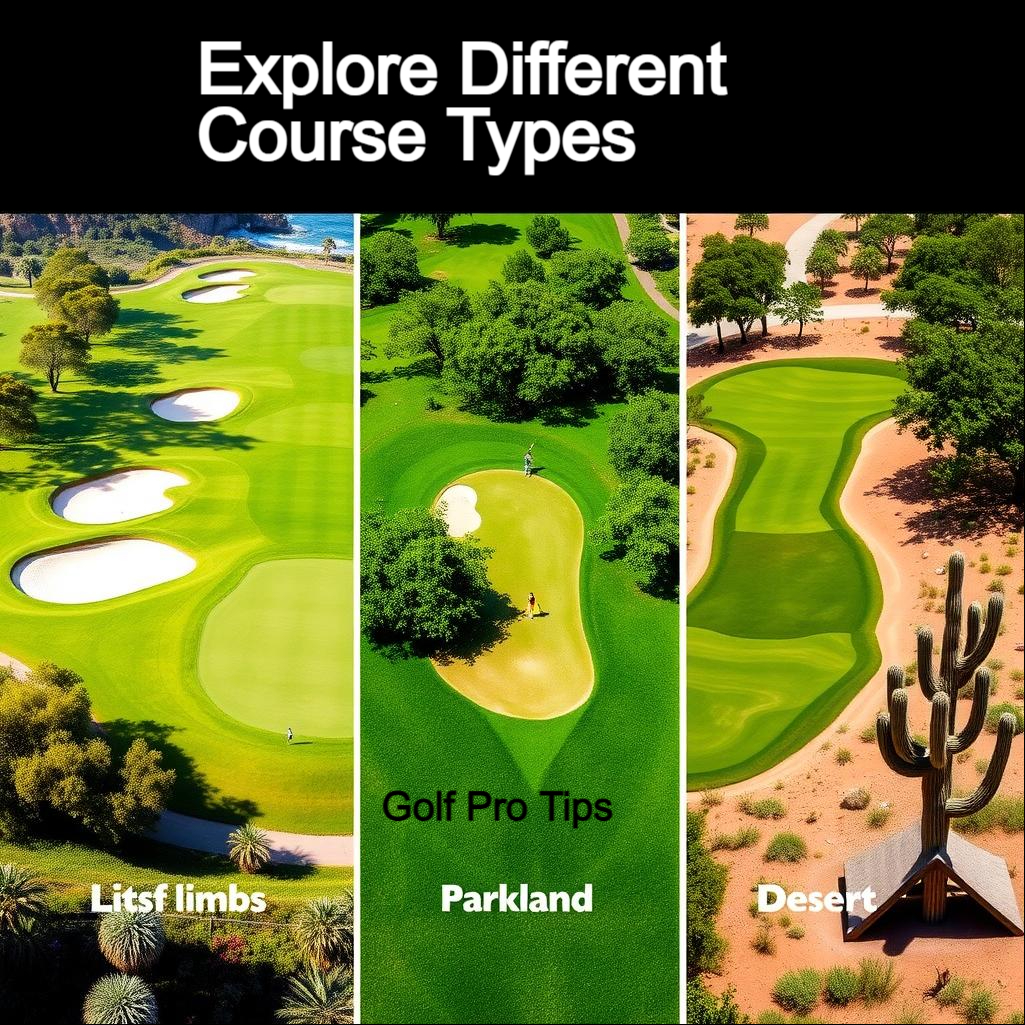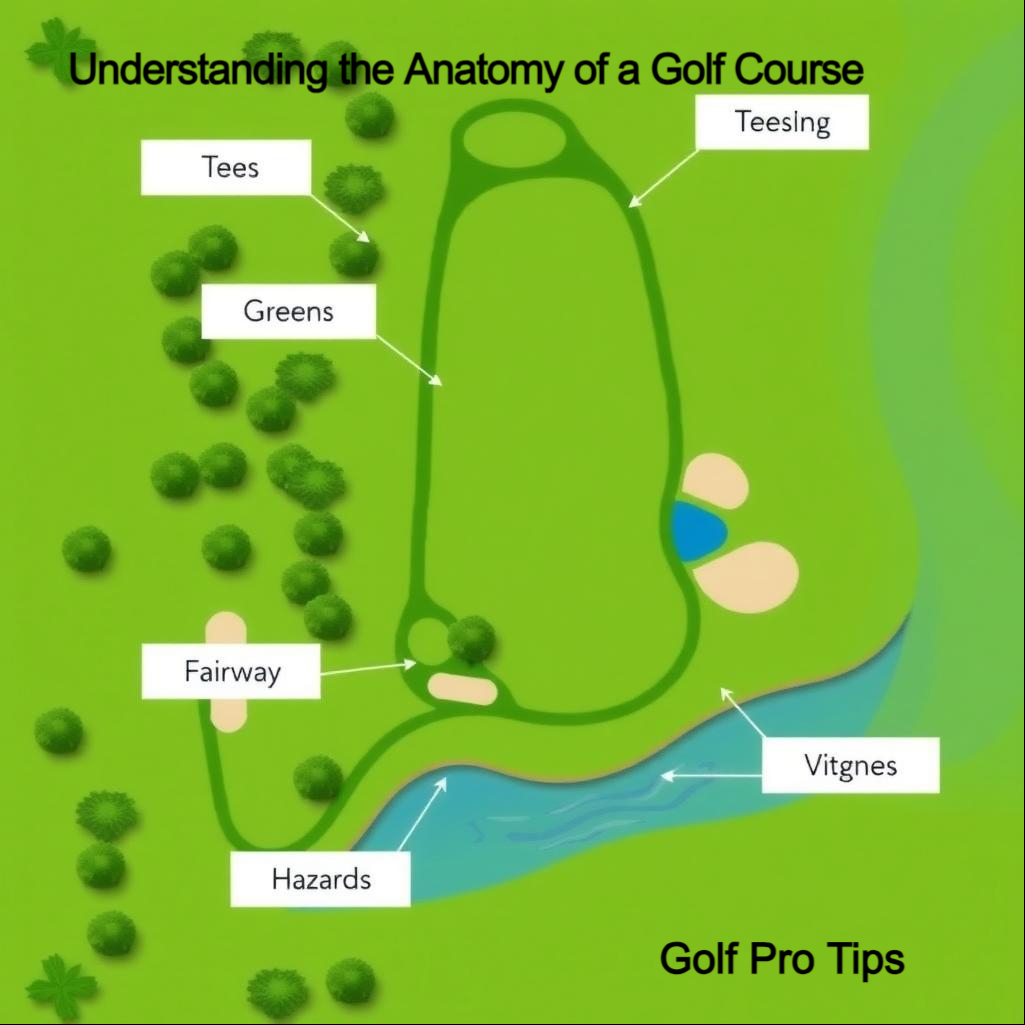10 Brilliant Golf Course Tips for Beginners: Play Smarter, Not Harder

Table of Contents
Key Takeaways
- Learn about the various styles of golf course, such as links and parkland. Find out how their special skills can affect your game plan and approach to the game!
- Understanding basic course elements such as tees, fairways, rough, and hazards will help you make better decisions with your shots and play better overall.
- Create a course management mentality by weighing risk and reward on every shot. Develop a round strategy to improve your trust!
- Use course guides and hole layouts to determine smart shot placements. Change your game plan to account for weather and course conditions.
- Master club selection by experimenting with different clubs and using technology to improve accuracy and decision-making.
- Respect the rules of golf etiquette & keeping up the pace of play. Enact a course repair plan so everyone can enjoy a well-kept course!
As a beginner, you want to get more experienced players’ advice on course management. They need to develop crucial technique and learn to pace themselves on the course.

Getting used to the course’s unique characteristics, including hazards and common pin placements, can do wonders for your in-play decision-making. Building confidence and precision with key skills, such as putting and chipping, is essential to achieving lower scores.
Not rushing or getting ahead of oneself during the course of the round will keep concentration and momentum high. With the right balance of all three of these factors, beginners will have a more rewarding experience and develop a more well-rounded game.
This blog will look at some practical tips and techniques to make sure new golfers have successful first rounds.
Understanding Golf Course Basics
Good golf course management is essential for beginners to improve their overall strategy. Understanding golf course layouts, types, and difficulty levels will guide your approach, enhancing your golf journey and boosting performance.
1. Explore Different Course Types

- Links Courses: Typically located near coastlines, featuring sandy soil and natural dunes. With strategy often revolving around wind management.
- Parkland Courses: Characterized by lush greenery and trees, these courses demand accuracy and strategic shot placement.
- Desert Courses: Usually presenting a stark contrast between lush fairways and surrounding sand, they challenge players with unique hazards.
Each golf course layout shapes the way you play. Links courses are known for encouraging more ground play due to their inherently firmer conditions, while parkland courses reward shots from the air.
2. Learn Key Course Components

A typical golf course is made up of 18 holes, and each hole offers a different combination of risks. These key components make up the basis of a golf course—tees, fairways, greens, and hazards.
Understanding par ratings helps gauge course difficulty. For example, a par-72 course typically offers more strategic opportunities than a par-54. Understanding how each of these components influence shot strategy and club selection is essential.
New players can get by with the basics. Don’t feel like lugging 14 clubs around? Grab a driver, 7-iron, sand wedge, and putter to get the full experience without the full bag.
3. Familiarize with Course Design Elements

Key design elements such as bunkers, water hazards, and doglegs significantly influence approach shots. Evaluating these elements can refine strategy.
For instance, a well-placed dogleg may require an alternative route to avoid hazards. Studying famous course designs, like Augusta National, provides insight into strategic layouts.
Developing a Strategic Mindset
Having a strategic mindset in golf is key to overcoming some of the toughest challenges the sport has to offer. It includes the hard work of expectation management and attitude cultivation. High expectations set you up for disappointment, but a strong mindset builds perseverance when the going gets tough.
This is a smart way to make those investments. As an example, you want to shoot for the center of the fairway, not just the longest distance possible.
1. Adopt Mental and Physical Strategies

Mental strategies are key to a strategic mindset. Mental strategies like visualization, controlled breathing, and positive affirmations help increase concentration. Similarly, imagining making a bunch of shots before going into the game can increase a player’s confidence.
Adding physical training, such as endurance-building routines, keeps your energy level up over the course of your round. Mindfulness practices, which focus on being in the moment, strengthen your capacity to focus while in action.
2. Evaluate Risk vs. Reward in Shot Selection

Evaluating risks before hitting shots is critical, particularly on challenging holes. Calculating the risk vs reward of aggressive plays versus more conservative plays can be the difference in a good player and a great player.
For example, you can decide to attack a difficult pin position. Or, you can take the safer route, and that choice can make or break your round. Getting into the habit of evaluating risk vs reward will result in smarter choices.
3. Create a Pre-Round Game Plan

Articulating clear objectives ahead of your round sharpens your aim. Having a standard checklist of what to expect in different course conditions will make sure you are prepared, no matter what.
Creating a visual depiction of your game plan can go a long way toward instilling confidence and preparing you for success.
Navigating the Course Effectively
Navigating a golf course efficiently is critical not only to maximizing performance but also to enhancing the enjoyment of the game. Understanding the golf course layout and adapting to changing conditions is essential. Implementing effective golf course management strategies for tee shots and approaches can significantly impact a golfer’s experience and performance.
1. Read Course Guides and Layouts
Using course guides is a must. Learn where everything is at on the course, especially the distances of the holes, where hazards may appear and where greens are located.

Write out a bullet list of these specifics to carry as a cheat sheet for your quick reference while on the course. Familiarizing yourself with the scorecard can help shed light on par values and stroke index, so you can plan your round accordingly.
2. Plan Your Shots Wisely
That’s why planning each shot strategically is so important. Think about how far your subject is, the wind, obstacles.
Choose safe landing zones instead of risky plays, especially on the tougher holes. Getting a few practice swings in can develop a better sense of what the shot will look like.
Getting there early—at least 30 minutes before your tee time—allows you to stretch, practice a little and get in the right headspace. This allows for a deeper, more strategic game to emerge!
3. Adjust to Hazards and Weather Changes
Environmental considerations can have a huge impact on your game, be aware of environmental factors such as windy conditions or rain. Change your game plan to avoid hazards or obstacles like bunkers and water.

Avoiding these hazards and knowing where they are located will save strokes and prevent unwanted warnings to your round. Adaptability is key. Stay prepared to change your strategy as new circumstances arise.
Mastering Club Selection
The importance of selecting the right club in golf courses can’t be understated—it’s key to improving distance, control, and your overall performance. To master this golf course management tip, you need to know how each club will perform under different playing conditions and understand the subtleties of your own golf swing.
1. Understand the Role of Club Choice
Clubs from 60 degrees down to 2 degrees launch the ball on very different trajectories. For example, drivers are manufactured for distance first and foremost, but wedges are designed to provide accuracy around the green. Understanding your playing ability will allow you to select clubs that work well with your skill level.

Beginners can be better served by less punishing clubs, ones that improve playability. Get to know your clubs. Take time to experiment during practice rounds. By experimenting with different clubs you’ll soon find out which clubs give you the most productive results for your unique swing style.
2. Tips for Selecting the Right Club
When you’re choosing a club, consider your distance to the hole. In addition, consider the lie of the ball and the wind direction and speed. On a windy day, even a 7-iron might not be enough club for a 150-yard shot.
If the wind is in your face, you may need an extra club. Create a rule to guide your decision-making every time, like always focusing on the distance as a starting point. Consulting experienced golfers or trainers can offer personalized recommendations, further fine-tuning your selection.
3. Use Technology for Better Decisions
New golf GPS devices and apps can improve precision in club selection. These tools not only give you accurate yardage but measure your improvement over time. Truly analyzing your stats can help spot trends or patterns which you can use to inform decisions.
Technology like swing analysis tools can ensure you’re honing your technique, so you’re making a big impact when it counts on the course.
Enhancing Green Reading Skills
Enhancing green reading skills will go a long way towards delivering better putting performance. This skill enables golfers to visualize the progression of their ball over the green’s contours. They look at things such as slope and grain to make precise determinations.
By understanding these factors, golfers become better equipped to make smart choices which result in more effective putts.
1. Techniques for Effective Green Reading
- Reading the slope: Assess the incline of the green to predict the direction the ball will break.
- Visualizing the line: Imagine the ball’s path from the ball to the hole, considering how it will be affected by the slope.
- Assessing speed: Gauge how hard to hit the ball based on the green’s speed, which can vary due to moisture or grass type.

Moving around to approach the putt from different angles can show a more complete picture of your golf game. Taking note of how other players read the greens can provide great golf course management tips, showcasing techniques that work best, what to look for, and what to avoid.
2. Impact on Course Management
Developing effective green reading has immediate, tangible impacts on course management. By understanding how to read greens, players can better their decisions on where to place their shots, ensuring the best opportunity for success.
Being able to adjust strategy depending on the caliber of greens faced can make a huge difference in score results.
3. Practice Routines for Improvement
Developing a strong practice routine focused on green reading/putting is most important. By building drills that mirror real-game situations, players learn to adjust when it’s time to play for keeps.
By tracking progress, it becomes clear where further development is required, creating an incentive for continuous improvement.
Utilizing Practice Facilities
Learning to utilize practice facilities is the first step for any new golfer serious about taking their game to the next level. It’s on these players to make the most of their time spent at said venues. This method gets them a wider range of skills that the golf course can’t simulate.
Structured improvement opportunities exist on a range of different practice environments, like driving ranges, practice greens and chipping areas.
1. Maximize Time at the Driving Range
To fully benefit from driving range sessions, consider these practices:
- Warm-ups: Start with light stretching and practice swings.
- Target practice: Aim for specific targets to enhance accuracy.
- Swing drills: Focus on specific swing aspects like grip and follow-through.
Focus on One Thing at a Time. You don’t need to overhaul your entire swing after every practice session. Try out a variety of clubs and shot styles to broaden your range and flexibility.
2. Use the Practice Green Effectively
From the green, create a practice habit around short putts, lag putts and reading greens. Practice like you play — simulating real-course pressure situations, like having to make that five-foot putt with the imaginary gallery watching, gets you ready for real-course scenarios.
Include drills that help develop distance control as well as accuracy, so a complete putting skill set is developed.
3. Focus on Chipping Areas
Mark out important chipping areas around the greens, including tight lies and fringe areas to practice repeatedly for your golf course management tips.
- Short chip shots to improve touch.
- Longer chips to enhance feel and distance awareness.
- Shots from various lies and slopes to build adaptability.
Embracing Golf Etiquette and Maintenance
Learning the basics of golf etiquette is key to making sure everyone around you can enjoy their time on the course. It lays the groundwork for courteous engagement and fuels a sense of community among players.
Being courteous to your peers makes the game more fun for everyone while showing respect for the game and its players.
1. Importance of Proper Course Etiquette
A few key etiquette rules should always be observed:
- Silence during swings, allowing players to concentrate.
- Fixing divots and ball marks as soon as possible, helping to keep the course healthy and thriving.
- Keeping pace with the group ahead to maintain flow.
Showing consideration for your fellow golfers by being aware of their space and time creates a welcoming environment for everyone. Promoting proper sportsmanship adds a positive atmosphere, creating a more enjoyable game for all players.
2. Maintain Pace of Play and Respect Others
Keeping up with the pace of play is important to ensure everyone has an enjoyable experience. Be prepared to hit when it’s your turn to avoid holding up the group.
This small act goes a long way to ensure that everyone gets to enjoy uninterrupted play. Clear communication in your group about pace is key, so that everyone is on the same page and understands their role.
3. Repairing the Course After Play
It’s a necessary part of being responsible for how the course is maintained in your wake.
We’ve all been told many times to replace our divots and repair ball marks. When you take time to do this and encourage others to do the same, you help improve the overall quality of the course.
Stellar maintenance ensures that the course remains in excellent condition for other players, as well as continuing to enjoy its beauty.
Common Mistakes and How to Avoid Them
As beginning golfers learn the ways of the fairway, it’s easy for them to trip on plenty of mistakes that could be easily avoided. Knowing these common mistakes and how to avoid them is essential for smart growth.
By treating mistakes like important learning opportunities, we build creativity and boldness, and create a more beautiful game.
1. Identify Strategic Errors Beginners Make
Common errors include:
- Poor club selection, leading to inefficient shots.
- Neglecting course management, which can result in unnecessary strokes.
- Rushing shots, often resulting in mis-hits and frustration.
What have you mistaken for engagement, or even interest? Tie to specific examples where these errors took place. An example would be deploying a driver on a narrow hole instead of the appropriate club.
Feedback from advanced players can be truly enlightening—they’ll suggest things that will expose weaknesses in your strategy.
2. Learn from Past Experiences
Logging each round can be a helpful way to document not only your mistakes, but what you’ve done well. Write down what was successful and what was not, like particular clubs or approaches.
Digging into these submissions is the first step to honing your strategy year after year. Talking through your experiences with other golfers will add invaluable perspectives to your game, helping you learn new strategies, teach you different techniques, and so much more.
3. Stay Positive and Embrace Challenges
Developing a positive mindset is key to having an enjoyable round of golf. Instead, challenges should be seen as opportunities for development and improvement.
Surrounding yourself with inventive, fearless, high-character, supportive players can help foster that environment of exploration where positive change can happen.
Continuous Improvement and Adaptation
Providing clear and useful continuous improvement in golf is critical to new players improving their skills and overall enjoyment of the game. With a promise to continuous improvement, each player will be able to work their way down the path to success at every stage of their golf experience.
This promise means establishing attainable targets, modifying approaches as competencies develop, and recognizing success—even if it is just in small increments.
1. Track Progress and Set Goals
Making measurable goals is important for every golfer. Or set measurable goals like increasing swing speed, reducing handicap or score, or being able to hit certain shots consistently.
For example, maybe a new golfer has a goal of shooting five strokes lower on average over the next month. Consistently checking in on these goals keeps the fire lit and promotes accountability.
It’s critical to recalibrate these targets as skills evolve, to keep them ambitious but attainable.
2. Evolve Your Strategy as Skills Improve
As you and your staff gain experience, your course management strategies should evolve. Novices might need to adjust their strategy on how to get through the course, applying that new confidence to take better calculated risks.
Whether it’s adjusting club selection or practicing shot placement, experimentation can lead to performance improvements. Keeping an attitude of learning from both victories and defeats fosters a more profound approach to the game.
3. Enjoy the Journey of Learning
Golf is equally about the process as it is about getting better. Fostering a love for the learning journey helps players celebrate little victories, such as making a tough shot.
Connecting with other golfers and sharing personal experiences creates a positive environment and encourages others to work hard to reach their own goals.
Conclusion
Developing a smart strategy for the golf course is a learned and repeated process.
Keep things simple. Pay attention to the fundamentals.
Know the course and your equipment. Know the course layout and know what club to hit on each shot. Create a strategy for playing each hole, but stay mentally focused.
Just like fairways, giving special attention to the greens and practicing your green reading skills are vital to lowering your score. Take advantage of the practice facilities to develop your skills.
Never forget to have respect for the game as well as your fellow players. Understand what went wrong, change your approach, and win the next time.
Golf is a great sport to pick up as a beginner. Approach every round with an opportunity to learn. Immerse yourself in the sport, savor the experience, and see your game thrive. Get out there and play your shot!
Frequently Asked Questions
What is the importance of understanding golf course basics?
Understanding the golf course layout, including its hazards and unique features, provides beginner golfers with essential golf course management tips. This knowledge empowers players to adopt a strategic mindset, enhancing their overall golfing experience and enjoyment on the course.
How can I develop a strategic mindset in golf?
Begin by strategically thinking through each hole before teeing off, considering factors like yardage, wind direction, and your comfort level. This golf course management tip allows you to focus on your shots and minimize big errors that can significantly impact your golf game.
What should I focus on when navigating the course?
Observe the overall golf course layout, from tees to fairways to greens. Pay attention to where the hazards lie, and consider which approach will be the most secure to your objective. This golf course management tip will make you a more informed decision maker.
How do I choose the right golf club?
Choosing the right golf club is crucial for a successful golf game. Consider distance, type of shot, and course strategy when selecting your club. Practicing with various golf shots will enhance your understanding of which club to use in different situations.
What are some techniques for reading greens?
Pay attention to the slope and grain of the grass when putting, as this is a crucial golf course management tip. From behind the ball, picture the line you want to take; consistent practice will enhance your ability to identify subtle breaks on the green.
How can I effectively use practice facilities?
Use driving ranges to work on your golf swing, and practice greens to develop short game and putting skills. Investing time in short game zones is crucial for beginner golfers to enhance their chipping and pitching skills, essential for scoring lower.
Why is golf etiquette important for beginners?
Golf etiquette ensures that other players and the golf course are respected. Being mindful of these expectations creates a friendly atmosphere, enhancing your golfing experience as you connect with other golfers on the course.
This article contains affiliate links. If you purchase through them, I may earn a small commission at no extra cost to you. See our Affiliate Disclosure.






